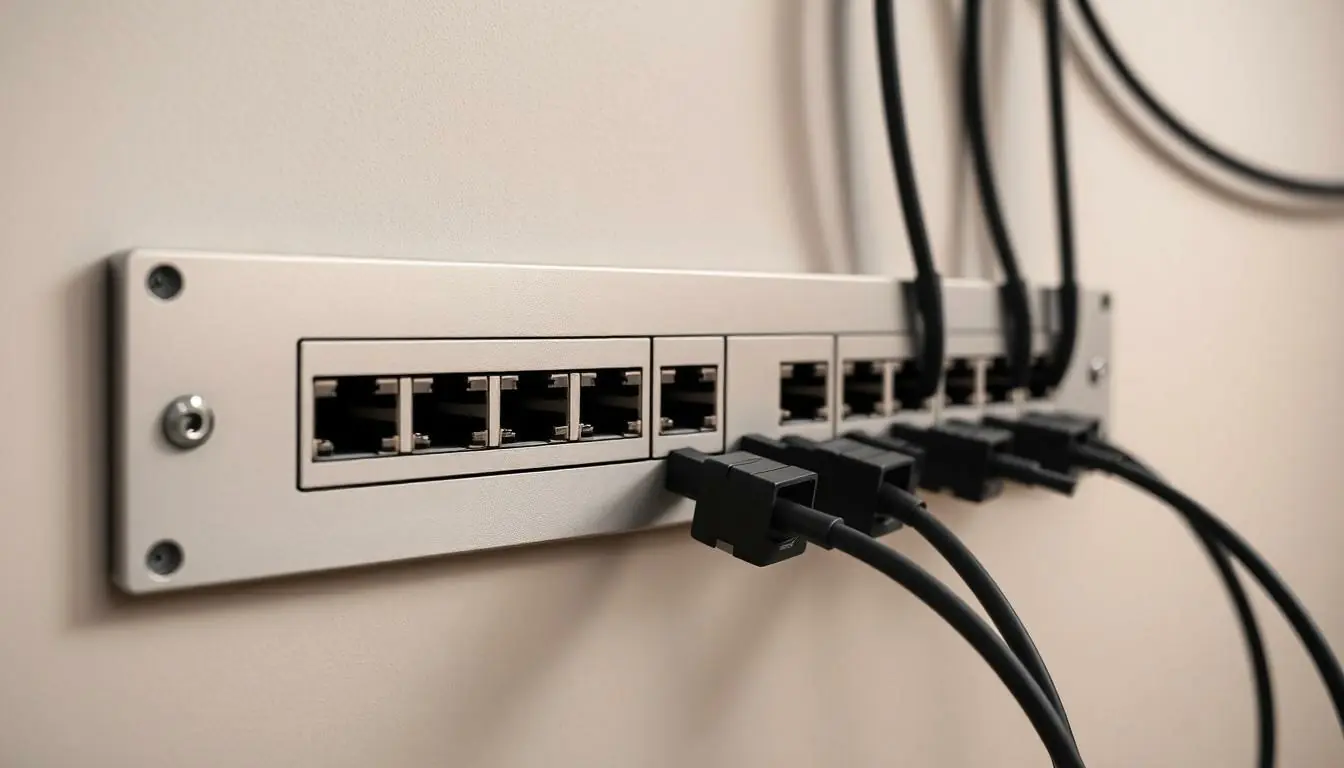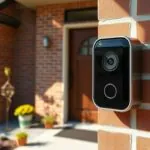Table of Contents
ToggleIn today’s tech-savvy world, a home networking panel isn’t just a luxury; it’s a necessity. Imagine a place where all your devices connect seamlessly, like a well-rehearsed dance routine. Without it, your Wi-Fi might feel more like a game of hide-and-seek than the reliable connection you deserve.
Installing a home networking panel can transform your chaotic cables into a harmonious symphony of connectivity. It’s like giving your home the tech makeover it never knew it needed. Say goodbye to the tangled mess behind your TV and hello to organized bliss! With the right setup, streaming, gaming, and working from home become as smooth as butter on hot toast. Ready to elevate your home network game? Let’s dive into the world of networking panels and discover how they can revolutionize your digital experience.
Overview of Home Networking Panels
Home networking panels organize and manage network connections for various devices. Various components within these panels, such as switches and routers, play crucial roles in enhancing overall network performance. By centralizing connections, users experience reduced cable clutter and simplified network management.
Professionals often recommend installing a networking panel in homes with multiple devices to support activities like streaming and gaming. A well-structured panel maximizes Wi-Fi signal strength, delivering reliable connectivity for remote work and online gaming. Effortless integration with smart home devices further increases the value of networking panels for modern households.
Different types of networking panels exist, catering to various needs and setups. For example, a basic patch panel can accommodate fewer connections, while larger, more advanced setups allow for extensive networks. These panels not only enhance performance but also boost aesthetic appeal by creating a neater appearance in utility areas.
Cost considerations also factor in the installation of a home networking panel. Quality panels range from $50 to several hundred dollars, depending on features and capacity. Investing in a networking panel often yields long-term benefits, making it a wise choice for homeowners focused on improved connectivity and performance.
Overall, home networking panels significantly improve digital experiences in modern households. They ensure stable connections, enabling users to navigate today’s technology-driven environment effectively.
Key Features of Home Networking Panels

Home networking panels provide essential features that enhance connectivity and organization. These features facilitate improved performance for modern households.
Port Configuration
Port configuration includes a variety of options tailored to specific networking needs. Gigabit Ethernet ports support high-speed connections, while additional ports accommodate future devices. Some panels offer Power over Ethernet (PoE) capabilities, allowing devices to receive power and data through a single cable. Flexibility in port arrangement enables users to customize their setup, ensuring optimal device placement throughout the home.
Cable Management
Effective cable management remains crucial for maintaining an organized network. Home networking panels typically include built-in mechanisms for securing and categorizing cables. Techniques like cable ties or clips help prevent tangling and improve airflow. Managing cables properly not only enhances aesthetics but also simplifies troubleshooting by making it easier to identify connections. A tidy environment promotes efficient operation and easy access for any necessary adjustments.
Size and Design
Size and design play pivotal roles in the functionality of networking panels. Compact models fit in smaller spaces, while larger units accommodate expansive networks. Aesthetic considerations also matter; sleek designs blend seamlessly with home decor. Some panels feature transparent or stylish casings that showcase technology without cluttering the living area. Customization options are available, allowing homeowners to select panels that best suit their individual preferences and needs.
Benefits of Using a Home Networking Panel
Home networking panels offer a variety of advantages that enhance digital connectivity and organization. They present invaluable improvements to everyday internet usage.
Improved Network Organization
Simplifying cable management stands as a primary benefit of home networking panels. Cables intertwined and cluttered often lead to confusion and difficulty in troubleshooting. Home networking panels provide structured placement for connections, making it easier to identify and access specific wires. Organized setups reduce the stress related to device management. Utilizing labeled ports ensures clarity for users when connecting or disconnecting devices. This organization enriches both functionality and aesthetics in utility areas, transforming chaotic spaces into streamlined networks.
Enhanced Network Performance
Boosting network performance greatly enhances user experience. Home networking panels centralize network connections, allowing devices to communicate more effectively. When multiple devices operate simultaneously, the risk of bandwidth congestion decreases with an organized system. Enhanced signal strength promotes faster data transfer rates, directly impacting streaming and gaming capabilities. Reliable connections correlate with fewer interruptions and latency issues, fostering seamless online activities. For households with smart home technology, integrating these devices through a dedicated panel simplifies performance management and maximizes utility.
Popular Home Networking Panel Options
Home networking panels come in various designs and brands to suit different user needs. Evaluating options helps make informed decisions for optimal connectivity and performance.
Brand A Review
Brand A offers a versatile networking panel designed for both beginners and tech enthusiasts. It features multiple Gigabit Ethernet ports, ensuring high-speed connectivity for multiple devices. Users appreciate its compact size, which allows for easy installation in limited spaces. Built-in cable management tools contribute to an organized setup, reducing clutter and enhancing aesthetics. This brand particularly excels in reliability, providing consistent performance even during peak usage times. Additionally, it supports Power over Ethernet (PoE), simplifying the installation of compatible devices such as security cameras and access points.
Brand B Review
Brand B stands out with its user-friendly interface and robust build quality. Known for its customizable design, this networking panel accommodates varying port configurations, making it suitable for expanding networks. Users find its color-coded ports helpful for straightforward cable management, leading to easier troubleshooting. Enhanced signal strength maximizes the efficiency of connected devices, especially during data-intensive activities like gaming and streaming. Positive reviews highlight its durability and longevity, reinforcing Brand B’s reputation as a reliable choice for home networking needs. Overall, this option balances functionality and aesthetics effectively.
Installation Tips for Home Networking Panels
Proper installation of a home networking panel ensures optimal performance and reliability. First, choose a location that offers easy access and is away from moisture. Basement or garage areas often house wiring but consider placing panels in more accessible spots for maintenance.
Next, assess the number of devices in use. Understanding the required ports helps determine the size and type of panel needed. Selecting a panel with extra ports accommodates future expansions, ensuring flexibility.
After selecting a panel, gather essential tools such as a screwdriver, cable tester, and scissors. These tools simplify the installation process, eliminating frustrations during setup. Follow the manufacturer’s guidelines closely, as instructions provide crucial details that enhance user experience.
Organizing cables is critical for both performance and aesthetics. Using cable ties and labels maintains a clean appearance and simplifies troubleshooting. Coupling color-coded cables with designated slots in the panel aids in quick identification.
Testing the connections after installation is vital. A cable tester helps confirm all connections are functioning properly. Verifying signal strength ensures reliable network performance, particularly for streaming and gaming.
Finally, keeping the panel clean and dust-free extends its lifespan. Regular maintenance checks prevent buildup that could impede performance. By following these installation tips, users significantly enhance their home networking experience, leveraging the full potential of their devices.
Investing in a home networking panel is a smart move for anyone looking to enhance their digital experience. With the ability to streamline connections and improve Wi-Fi reliability, these panels make managing multiple devices a breeze. They not only reduce cable clutter but also contribute to a more organized and aesthetically pleasing environment.
Whether it’s for gaming, streaming, or remote work, a networking panel can significantly boost performance. By carefully selecting the right type and brand, homeowners can ensure optimal connectivity tailored to their specific needs. With proper installation and maintenance, a home networking panel will serve as a reliable foundation for a robust and efficient home network.





